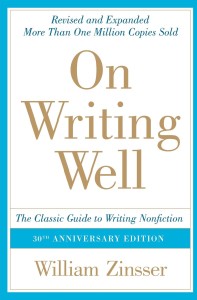By William Zinsser. 1980.
Chapter 1: The Transaction
I then said that the professional writer must establish a daily schedule and stick to it. I said that writing is a craft, not an art, and that the man who runs away from his craft because he lacks inspiration is fooling himself. He is also going broke.
For ultimately the product that every writer has to sell is not his subject, but who he is. I often find myself reading with interest about a topic that I never thought would interest me–some unusual scientific quest, for instance. What holds me is the enthusiasm of the writer for his field.
Chapter 2: Simplicity
But the secret of good writing is to strip every sentence to its cleanest components. Every word that serves no function, every long word that could be a short word, every adverb which carries the same meaning that is already in the verb, every passive construction that leaves the reader unsure of who is doing what–these are the thousand and one adulterants that weaken the strength of a sentence.
The answer is to clear our heads of clutter. Clear thinking becomes clear writing: one can’t exist without the other. It is impossible for a muddy thinker to write good English.
The writer must therefore constantly ask himself: What am I trying to say? Surprisingly often, he doesn’t know. Then he must look at what he has written and ask: Have I said it? Is it clear to someone encountering the subject for the first time?
I don’t mean that some people are born clear-headed and are therefore natural writers, whereas others are naturally fuzzy and will never write well. Thinking clearly is a conscious act that the writer must force upon himself, just as if he were embarking on any other project that requires logic: adding up a laundry list or doing an algebra problem. Good writing doesn’t come naturally, though most people obviously think it does. The professional writer is forever being bearded by strangers who say that they’d like to “try a little writing sometime” when they retire from their real profession. Good writing takes self-discipline and, very often, self knowledge.
Chapter 5: The Audience
Soon after you confront this matter of preserving your identity, another question will occur to you: “Who am I writing for?” It is a fundamental question and it has a fundamental answer: you are writing for yourself. Don’t try to visualize the great mass audience. There is no such audience–every reader is a different person.
You write primarily to entertain yourself, and if you go about it with confidence you will also entertain the readers who are worth writing for. If you lose the dullards back in the dust, that’s where they belong.
But on the larger issue of whether the reader likes you, or likes what you are saying, or how you are saying it, or agrees with it, or feels an affinity for your sense of humor or your vision of life, don’t give him a moment’s worry. You are who you are, he is who he is, and either you will get along or you won’t.
Chapter 6: Words
If all your sentences move at the same plodding gait, which even you recognize as deadly but don’t know how to cure, read them aloud. You will begin to hear where the trouble lies. See if you can gain a variety by reversing the order of a sentence, by substituting a word that has freshness or oddity, by altering the length of your sentences so that they don’t all sound as if they came out of the same computer. An occasional short sentence can carry a tremendous punch. It stays in the reader’s ear.
Chapter 8: Unity
All writing is ultimately a question of solving a problem. It may be a problem of where to obtain the facts, or how to organize the material. It may be a problem of approach or attitude, tone or style. Whatever it is, it has to be confronted and solved.
Every successful piece of nonfiction should leave the reader with one provocative thought that he didn’t have before. Not two thoughts, or five–just one. So try to decide what point you most want to leave in the reader’s mind. It will not only give you a better idea of what route you ought to follow and what destination you hope to reach; it will also affect your decision about tone and attitude. Some points are best made by dry understatement, some by heavy irony.
Chapter 10: The Ending
Surprise is one of the most refreshing commodities in nonfiction and, as I’ll try to demonstrate next, there is nothing like human detail to make a story come alive.
Make active verbs activate your sentences, and try to avoid the kind that need appended preposition or two to complete their work. Don’t “set up” a business that you can establish. Don’t “come upon” an object that you can discover, or “take hold of” one that you can grab. Don’t “put up with” pain, bear it.
Chapter 13: Bits & Pieces
Keep your paragraphs short, especially if you are writing for a newspaper or a magazine that sets its type in a narrow width. This is purely visual and psychological advice. Short paragraphs put air around what you write and make it look inviting, whereas one long chunk of type can discourage the reader from even starting to read. A newspaper paragraph generally shouldn’t have more than two or three sentences.
Your subconscious mind does more writing than you think. Often you will spend a whole day trying to fight your way out of some verbal thicket in which you seem to be tangled beyond salvation. Surprisingly often a solution will occur to you the next morning when you plunge back in. While you slept, your writers mind didn’t. To some extent a writer is always working.

